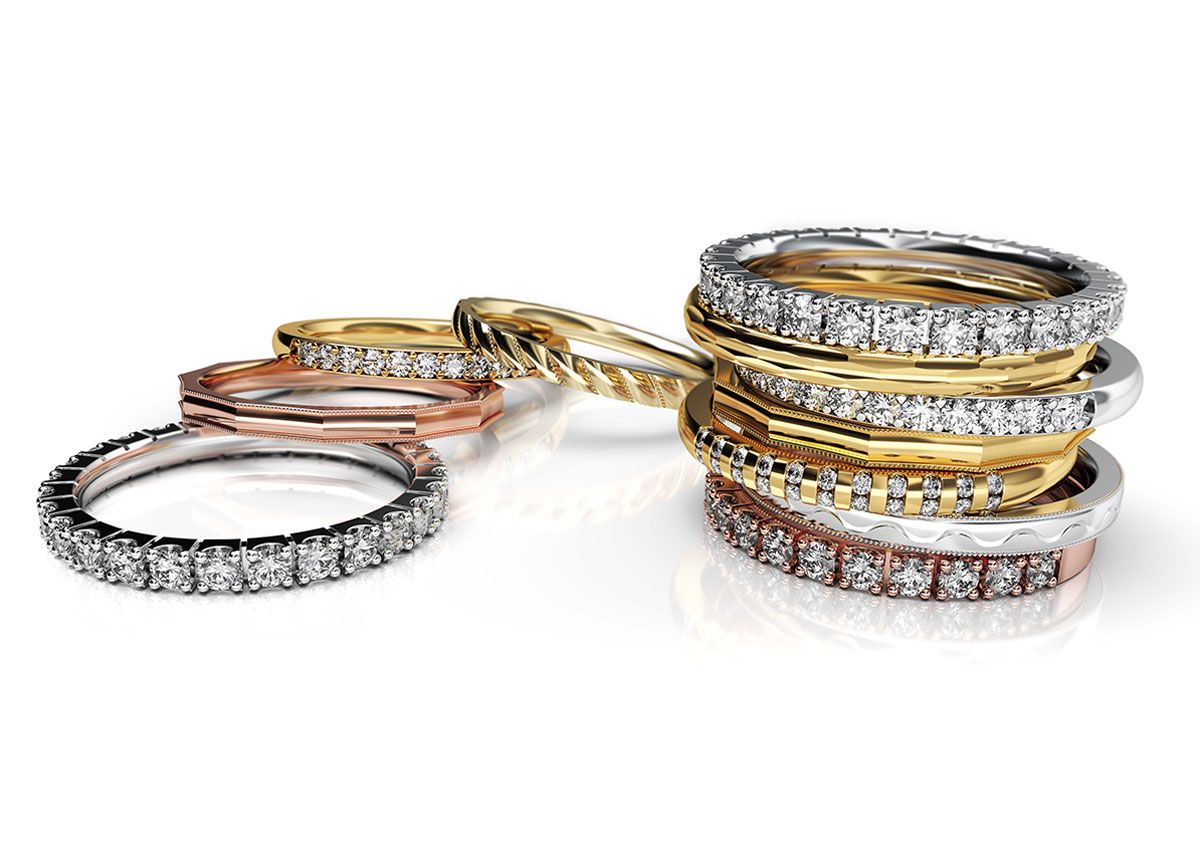
Our Metals, Explained
The Kuczora Design Center provides you with almost endless customization options, but one of the most important decisions you’ll make is your choice of metal for your custom ring. There’s no “best” choice; all of our metal options are high-quality precious metals, and they all create beautiful, striking effects in any combination in mixed-metal pieces. Which one (or ones) you choose is entirely up to you, whether it’s something that compliments your and your partner’s skin tones or combines colors and patterns in a way that expresses something meaningful about your relationship.
Platinum
If you’re after a sleek and modern look, you can’t beat the combination of platinum and diamonds. It is a soft but strong metal, which means that dents can be polished out. When platinum gets dented, it doesn’t chip and lose mass; the metal is simply moved out of place, so buffing can return it to its original smoothness. As platinum ages, it takes on a patina—a hazier, less lustrous finish. Just like the little scratches that might accumulate with years of wear, platinum’s patina adds to its character. It’s beautiful and poetic that our platinum jewelry ages with us, accumulating new lines every year and developing a different kind of beauty just like we do, a beauty representing wisdom and experience rather than the enthusiasm of youth. But if you don’t like the look of wear on your shiny white ring, you can just as easily keep it clean, polished, and looking brand new.
We offer two alloys of platinum: PT600, which contains 60% platinum and 40% other metals, often other platinum group metals. Each manufacturer has their own proprietary mix, designed to achieve specific qualities. Our particular recipe is like a master chef’s blend of herbs and spices: a closely guarded secret! PT950, on the other hand, is as close to pure platinum as you can get. The two are indistinguishable to the naked eye, but PT600 is the more affordable option. It is also a more modern innovation in comparison to the more traditional and widely recognized PT950.
Palladium
Palladium shares a lot in common with platinum. In fact, it is part of the platinum group of metals, a group of metals that have similar properties as platinum. It’s just a shade darker than platinum, and it’s also a little harder, making it a better choice for pieces that will see a lot of wear. Despite being harder than platinum, it is actually less dense and therefore lighter in weight than platinum. Despite these advantages, it is still rare to find palladium jewelry, but its popularity is beginning to grow in the US market.
Palladium is a newcomer on the jewelry scene, and the skill required to work with it is not one every jeweler has learned yet. At Kuczora & Co, we love learning new techniques, working with new technology, and combining new knowledge with traditional craftsmanship in ways that evolve our artform.
Yellow Gold
While pure, 24k gold does not tarnish, its malleability does not make it a great metal for jewelry—especially pieces you intend to wear often. Just bumping your finger on a counter can bend soft 24k gold out of shape. On top of that, not everybody likes the extremely golden hue of 24k gold.
Yellow gold solves both of those problems by combining gold with a slightly harder metal. This tones down the color of the gold while making it stronger and more durable.
White Gold
White gold is a gold alloy that combines gold with a white metal, typically palladium, silver, or nickel. Nickel allergies being incredibly common, all of our alloys are nickel free for your safety. We will never use allergenic metals when alternatives are available.
In addition to our 14k and 18k white gold alloys, we offer a “white gold (PD)” option, which is brighter than regular white gold. You also have the option of adding rhodium plating to a white gold ring to achieve that same shiny finish.
Peach Gold
This gold alloy sits somewhere between yellow gold and rose gold in hue. Rose gold is a fun variation that looks great with the right gemstone, but many people find it doesn’t work with their skin tone. Peach gold is perfect for someone who wants something a little different but feels that rose gold doesn’t quite work on them.
Red Gold
Want something different but bolder and more dramatic than peach gold? Red gold is for you. Its rich, coppery hue looks great beside palladium or white gold and brings out the sparkle of your diamonds.
Try It Yourself
Want to see for yourself how these metals look together? Head over to the Design Center in the menu at the top of the page and start experimenting. We can’t wait to bring your design to life.